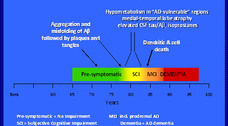Alzheimer's disease: A ticking bomb

Canada and the world face a ruinous increase in the incidence of dementia caused by Alzheimer’s disease (AD). Around the globe, more than 35 million people have dementia. Their care costs $600 billion each year, or almost 1% of the planet’s Gross Domestic Product. In Canada alone there are more than 450,000 whose cost of care exceeds $6 billion.
By the year 2050, unless we learn to prevent AD, the numbers of cases will grow to 115 million worldwide, with 1.3 million in Canada. By that time, global costs will exceed $2 trillion each year. To illustrate the scope of the problem, in the interim, the U.S. will have spent some $14 trillion, more than its entire current national debt.
Prevention rather than treatment
 |
| Click to enlarge |
Despite enormous efforts, no new AD therapy has received regulatory approval since 2003. As a result, it is now thought that AD symptoms, once they are evident, cannot be reversed. Thus, in the past few years the AD field has turned to prevention. But the problem here is that AD prevention trials face huge hurdles. They have enormous costs and need 7 or more years for completion. Clearly, we need to “get it right.”
The mission of the StoP-AD Centre is to learn to prevent AD symptoms by intervening in the pre-symptomatic stages of the disease.
Our approach begins with new knowledge that AD dementia is the end stage of a chronic disease that unfolds with silent brain changes over decades. This “latent”, or pre-symptomatic stage of AD is the ideal target for intervention because treatments at this point may avoid symptoms altogether.
Finding the right biomarkers
Biomarkers are the key to investigation of pre-symptomatic AD.
Pre-symptomatic AD cannot be investigated by relying on clinical symptoms. Instead, we need other indicators to reveal the development of the biological process. These indicators are called biomarkers. They may include changes in neuroimaging results as well as in the chemistry of cerebrospinal fluid (CSF) or other body fluids. The study of AD biomarkers will provide the best chance of advancing the cause of AD prevention.
Goals of the StoP-AD Centre
The goals of the StoP-AD Centre are to :
- Develop biomarker measures of pre-symptomatic AD
- Use these measures in pilot randomized trials of treatments to learn whether they will likely prevent the later development of symptoms
And if the results of these trials are encouraging :
- Undertake laboratory research to explain how and why some treatments slow the disease before symptoms are present, and thus to help improve on these treatments
Contact
StoP-AD Centre
Douglas Institute
Perry Pavillion, Room E-2210
6875, LaSalle boulevard
Montreal (Quebec) H4H 1R3
Tel.: 514-761-6131, ext. 3940
dina_dot_carmo_At_douglas_dot_mcgill_dot_ca


